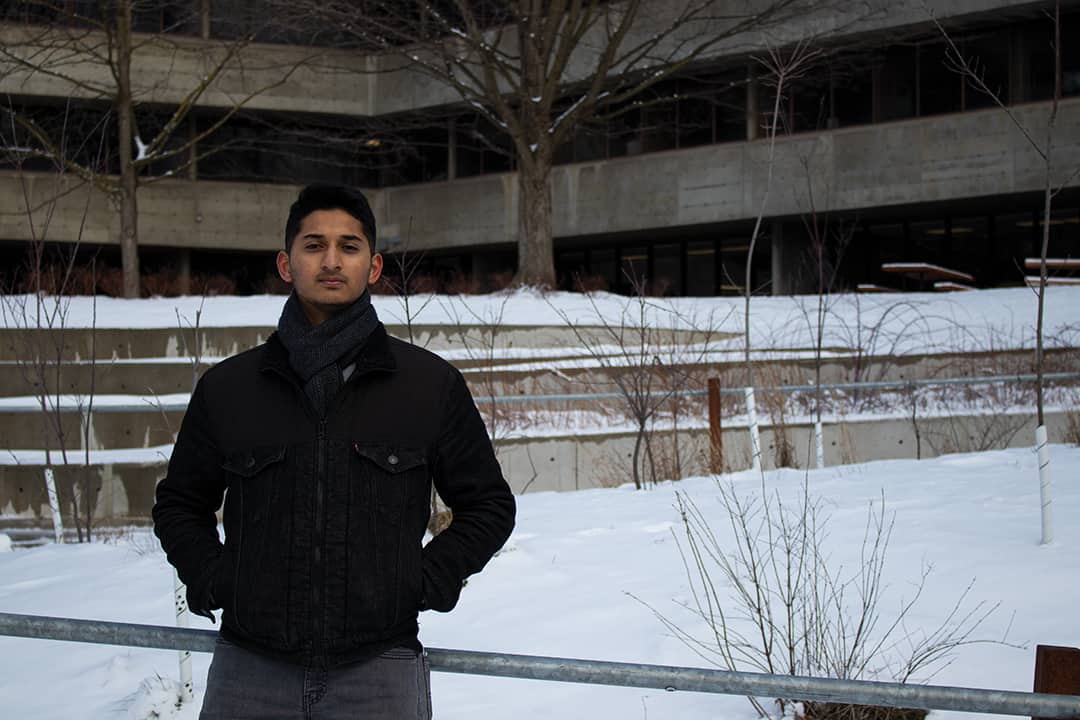This is the first part in a three-part investigation by The Varsity into international students’ financial struggles at U of T.
Content warning: This article mentions suicide.
It was mid-April 2021. The second wave of the pandemic was ravaging India. People waited in line to receive medical care, and hospital staff were trying to cope with shortages of ventilators and oxygen tanks. Delhi was engulfed in sirens, and 18-year-old Shoena Agarwal had just tested positive for COVID-19.
Shoena had also just received an email from U of T.
The university had made a decision on her application. She had just logged into her ‘Join U of T’ account when she saw a word that would change her life forever — “congratulations.”
So, despite the fact that her mother and younger brother had also tested positive for COVID-19, the fact that Shoena’s family hadn’t seen each other for more than two weeks because of quarantine, and the fact that 200,000 new cases and 1,000 deaths were being reported daily in India, there was a cause for celebration in the Agarwals’ apartment that summer day.
“Everyone was jumping around and everyone was just so happy,” Shoena says, as she and her family hopped on a video call to celebrate. “I never thought I would get into U of T.”
But there was one catch. No matter how many times they pored over their bank statements, Shoena and her family were confronted with one indisputable fact: they could not afford the $58,160 tuition fee that U of T charges international undergraduate students every year.
“Everything used to come down to [the fact that] we won’t be able to pay it,” Shoena says. “My parents just said that we can’t do it, like we literally can’t do it.”
It was hard to let the opportunity pass, though. The prospect of studying at the number one university in Canada — among the top 20 in the world, according to various league tables — captivated Shoena. “It was a dream come true,” she says.
Armed with a degree from a world-renowned university, Shoena could drastically increase her employment prospects. She could also immigrate to Canada. She’s deeply attached to her home country, but she often confronts a sense of choicelessness there. “I want things for myself which I know I will never get in India,” Shoena says.
Back home, people pressured her to think about marriage, when all she wanted to do was chase after her dream career. “There are still people around me back in my home country [who] are not okay with the fact of a girl studying so much,” she says. Shoena feared the societal pressure to leave her career at any time to devote herself to her husband, family, and home. “I don’t want to do that,” she asserts.
Shoena did not want, four years down the line, to wonder how differently her life might have turned out if she had just accepted U of T’s offer letter when it had arrived at her doorstep — when the opportunity to build a better future for herself was right there in front of her.
Eventually, it was decided: Shoena’s family would empty out her and her younger brother’s education funds, and take out a loan from a private insurance company. These measures, they reasoned, should help cover the approximately $240,000 that her U of T degree would cost.
A tenfold tuition disparity
International students in Canada typically pay tuition fees two to five times higher than domestic students. But at U of T, international students pay almost 10 times the amount their domestic counterparts pay for tuition.
Undergraduate international students who entered the Faculty of Arts & Science (FAS), UTM, and UTSC in 2021 pay $58,160 a year in tuition alone. In contrast, undergraduate domestic students in the same faculties pay $6,100 a year. This means that a full year for domestic students at U of T costs around the same as just one course for international students.
It comes as no surprise, then, that U of T’s international undergraduate tuition is the highest among universities in Canada.
With such a hefty price tag attached to their status at the university, it’s no wonder that stereotypes about international students abound. They park their shiny Bugattis next to domestic students’ stained Sedans; their Prada coats brush against domestic students’ sweatpants; and they shove their notebooks and pens into Louis Vuitton bags. These stereotypes imply that international students are obscenely rich — maybe even a little arrogant. These stereotypes are also racialized, since they often target East Asian international students.
But with almost 25,000 of them on campus, most of U of T’s international students simply do not fit this trope.
Yes, there are international students who are wealthy. Akaash Palaparthy, a third-year international student from India, says that he knows a U of T international student who owns two cars and who recently bought a house. But he asserts that such international students are “a very small minority.”
In September, The Varsity reported on international students who struggled to afford plane tickets and housing. The International Students’ Advocacy Network (ISAN) also wrote that some international students were unable to continue their studies at U of T due to “financial reasons.”
The COVID-19 pandemic has intensified discussions at U of T about international students. While classes were fully online in the 2020–2021 academic year, U of T increased international tuition by an average of 5.3 per cent, although domestic tuition remained frozen per a provincial government mandate.
By the end of the academic year, though, the university as a whole still incurred a net income of $726 million, and over 40 per cent of its total revenue came from international tuition.
Apart from isolation and online learning, international students have struggled with timezone differences, anxieties with border restrictions, and being apart from family during the pandemic. They’re also left out of government grants such as the Canada Emergency Student Benefit.
In addition, recent international student graduates are at risk of deportation. As the labour market shrunk during the pandemic, many struggled to fulfill the employment requirements for permanent residency. As a result, many former international students were faced with a tough decision, said Sarom Rho, the lead organizer of Migrant Students United, a branch of the advocacy group Migrant Workers Alliance for Change, in an interview with The Varsity: “Either deportation or making the decision to stay and become undocumented.”
It’s not hard to see, then, why international students across Canada have been grappling with a mental health crisis. According to the High Commissioner of India to Canada, eight Indian international students have died by suicide since 2020. Experts believe that many more deaths like these go unreported across the country, as stigma surrounding suicide remains widespread.
Ultimately, international students at U of T do not lead the luxurious lifestyles that many domestic students imagine. In fact, the results from a four-month investigation by The Varsity reveals that the truth is quite different. Interviews with almost 20 international students, alumni, experts, and student leaders, alongside an analysis of hundreds of pages of documents dating back to the mid-twentieth century, show that international students are often financially precarious.
They go to great lengths to pay exorbitant tuition, just to be met with exploitation, a precarious legal status, and a consistent lack of support in Canada. They are distressed and guilt-ridden. They take risky measures to afford their education — all for a shot at a better life.
Making ends meet
Rebecca Sinner is a first-year international student from South Africa. To attend U of T, she had to cobble together a patchwork of financial sources: her father would pay for two years of tuition, her grandfather’s inheritance would cover three quarters of a year, and her co-op placement would cover the rest. In the eight months before her flight to Toronto, she also spent eight to 11 hours a day working as a babysitter and nursery school assistant.
Even though Rebecca loves her home country, she doesn’t envision a future there. “As a woman, it’s just so dangerous,” she says. “My mom wanted my brother and I to get out… And one of the ways of doing that is when you study overseas — it’s easier to find a job there and then afterwards live there.”
Her budget seemed to be all set — or, at least, so she thought.
Later on, hidden expenses began to accrue. She did not anticipate that tuition would have to be paid in lump sums every September and November, and that paying from a bank outside Canada would incur additional transfer costs. The U of T recruitment officer who came to her school, she said, was not transparent about the true costs of food, transportation, and living in Toronto, either.
“They just go, ‘$9,500 for residence, $60,000 for tuition… and then it’s probably $5,000 for living [per year].’ That’s all they say. They don’t [mention] the travel expenses if you need to get to the shops. They don’t say how far all the shops are from residence. They don’t say all these things.”
Rebecca says the recruitment officer was also not transparent about the true availability of scholarships for international students.
“They just say there’s so much help available. But I think it’s also an advertisement to get you to come to the university,” Rebecca claims. “They just go, ‘It’s so much cheaper than America, you should definitely come.’ ” The U of T recruitment officer who came to present at her school had said there were many scholarships for international students, but hadn’t given any details about them. Later on, when Rebecca went to search for these scholarships, she discovered that there are not that many of them.
According to a university spokesperson, U of T allocated $42.6 million to supporting both international undergraduate and graduate students in the 2021–2022 academic year. They added that international students are eligible for around 5,300 of the university’s merit-based awards. Some of these awards are specific to international students, while some are open to all students at U of T.

CAROLINE BELLAMY/THE VARSITY
Kauel Rajeshkumar Brahmbhatt, a first-year international student from Kenya, has tried looking for in-course scholarships as well, but found that most of them were exclusive to domestic students. The majority of the scholarships he found that were open to international students amounted to $1,500 to $2,000, and the highest value for a scholarship he saw was $5,000.
But these amounts are negligible compared to the cost of international tuition. “It doesn’t even [pay] for one course that I’ll be studying,” he says.
Scholarship opportunities are also unequal across faculties and programs. Arthur Hamdani, a second-year international student from Indonesia, found that scholarships for international students are mainly available to those in management and life sciences. He could find none that are applicable for his majors, English and journalism.
The Lester B. Pearson Scholarship is the only scholarship that covers all tuition and living expenses for international students. As such, it is extremely competitive. Rebecca, Kauel, and Arthur all applied for it — but none of them got it. “It was heartbreaking,” Arthur says.
In 2021, only 37 out of the 2,237 applicants received the Pearson Scholarship. In other words, the acceptance rate was only 1.65 per cent.
The mental toll
Shoena is now in her first year at U of T. She says that international tuition fees are a sensitive topic for her “because there are a lot of dreams attached [to them].” Aside from getting a good education, Shoena chose to go to U of T because she wants to eventually work and live in a place where her “future will be better.” She feels that Canada has an easier pathway to permanent residency than other high-income countries.
This is why, despite the exorbitant fees, she perseveres. “Every day, I have to try to prove to myself and my parents that I’m doing my best, and that the money is worth it in the end,” she says. This means she pushes herself hard and feels guilty taking breaks. “I want to explore, I want to go out with my friends. But I won’t do that because I have such a big loan to pay.”
Grades reach a new level of importance when students are paying $5,816 for a single course. “If I don’t do well on a test, I start to panic,” she says. When she didn’t score well on her first term tests, she couldn’t bring herself to tell her parents, especially since many of her family members disagreed with her decision to study at U of T.
Indeed, because each course costs so much for them, none of the international students The Varsity interviewed had ever dropped a course past the 100 per cent refund deadline, which is typically at the end of the second week of term. Domestic students who drop a course and get 75 per cent of their money back only lose around $150. But for international students, they immediately lose around $1,500.
“It’s actually a lot of stress. And there are so many nights now that I’m studying and I just cry… I literally can’t handle all this,” Shoena says.

CAROLINE BELLAMY/THE VARSITY
Akaash cannot relate to the international students he knows at U of T who buy cars and houses. When he thinks about how much his parents spend on his education, he can’t shake the guilt. He says the air around him starts feeling “heavy.” He tracks his finances closely, and thinks twice about every purchase he makes. These constant considerations, he says, are “a little bit draining.”
U of T Professor Emeritus John P. Portelli, who studies social justice and equity issues in education, knows from firsthand experience that high international tuition fees create “a lot of stress.” In turn, he says, “[this stress] creates… additional stumbling blocks, which is not fair for international students.”
Portelli himself came to Canada in 1977 as an international graduate student from Malta. He says that being able to afford the international fees for his PhD at the time was “very tough.” He worked as a shipper for one summer, carrying boxes from warehouses to trucks. “I had to do it to survive,” he says.


